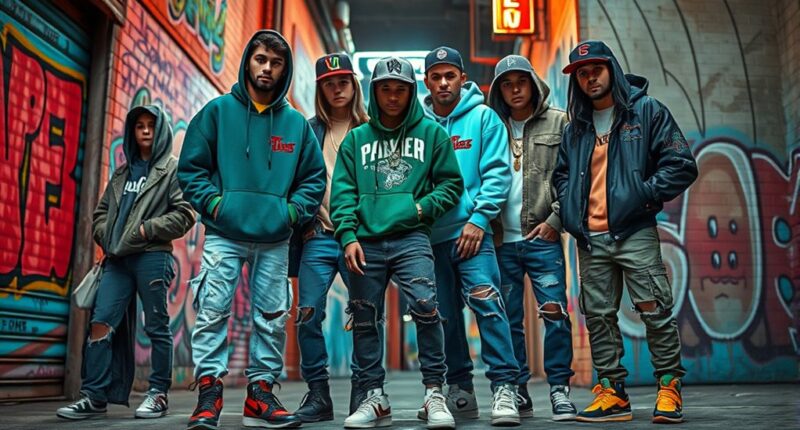Streetwear started in skate and punk scenes of the 1970s and 80s, emphasizing comfort, rebellion, and DIY style. It evolved through hip-hop culture in the 80s and 90s, turning street fashion into a bold way to express identity. Over time, brands collaborated with luxury designers, pushed limited drops, and embraced social media, driving its rise into mainstream high fashion. If you look closer, you’ll discover how these influences continue shaping today’s style landscape.
Key Takeaways
- Streetwear originated in 1970s-1980s skate and punk cultures, emphasizing self-expression, rebellion, and DIY aesthetics.
- The rise of hip-hop and urban communities in the 1980s-90s transformed streetwear into a powerful form of cultural identity.
- Collaborations with high-profile designers and luxury brands elevated streetwear from underground to mainstream fashion.
- Limited-edition drops and sneaker culture fueled hype, turning streetwear into a global status symbol.
- Influential artists and visual culture, like graffiti and street art, helped shape streetwear’s aesthetic and cultural significance.
Origins in Skate and Punk Cultures
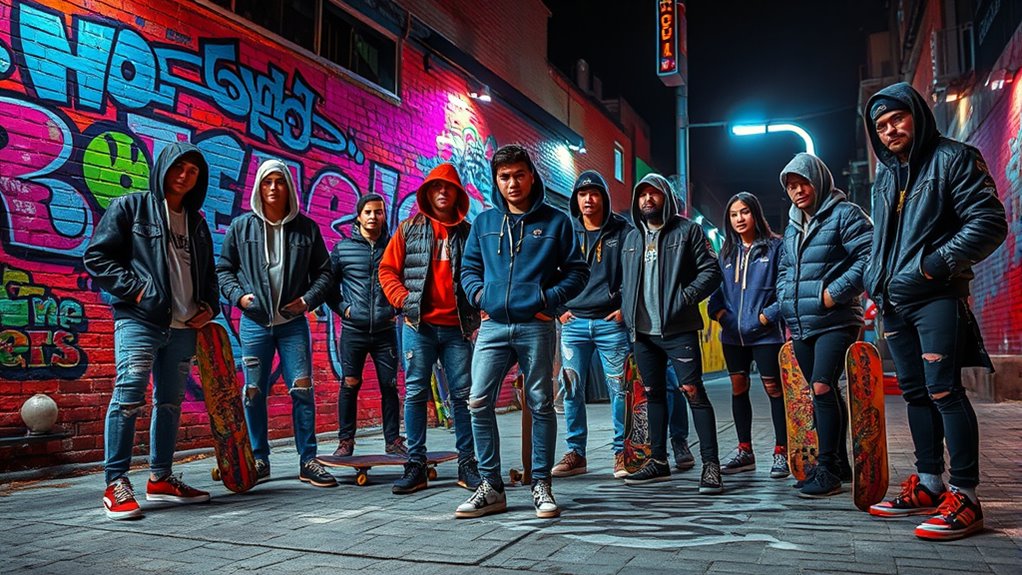
Streetwear’s roots can be traced back to the skate and punk scenes of the 1970s and 1980s, where the focus was on comfort, individuality, and rebellion. You’ll notice how vintage fabrics became a staple, giving each piece a unique, worn-in look that resonated with the DIY ethos of these cultures. Skaters and punks often repurposed old clothing, customizing and distressing garments to express their identity and reject mainstream fashion. This hands-on approach encouraged self-expression and authenticity, shaping the rebellious spirit of streetwear. The emphasis on vintage fabrics and DIY techniques fostered a sense of community and nonconformity. These elements laid the groundwork for streetwear’s evolution into a style that celebrates originality and defiance, often accompanied by a desire to challenge societal norms and foster individualism.
The Rise of Hip-Hop and Urban Expression
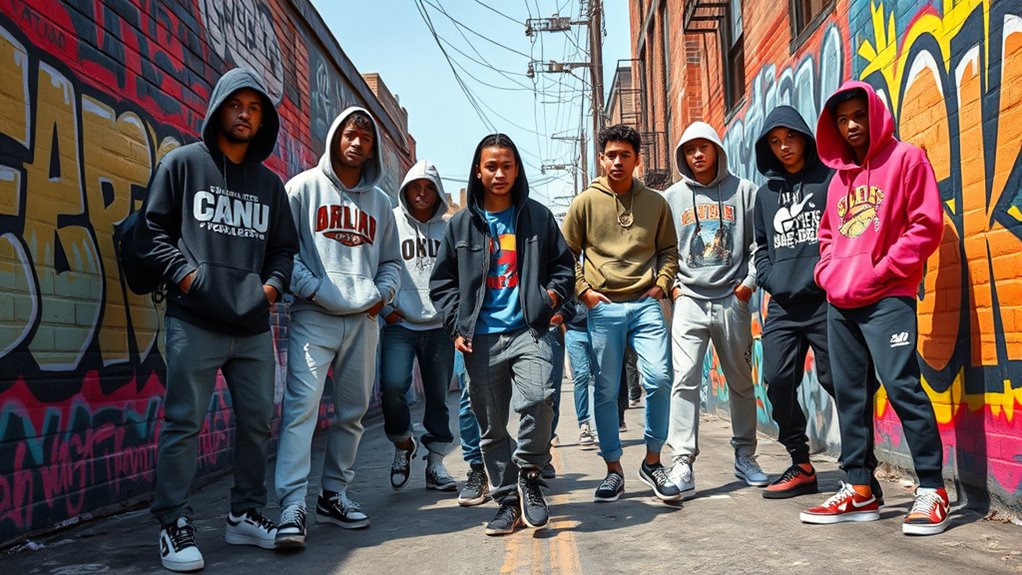
The rise of hip-hop and urban culture in the 1980s and 1990s dramatically transformed streetwear, turning it into a powerful form of self-expression. As artists and communities embraced bold styles, streetwear gained cultural significance beyond mere fashion. Brands began adopting luxury branding tactics, elevating streetwear’s status and appealing to a broader audience. Retail strategies shifted, with limited releases and exclusive collaborations fueling hype and demand. You start to see how streetwear becomes more than just clothing—it’s a statement of identity and attitude. Hip-hop’s influence pushes brands to innovate, blending street aesthetics with high-end elements. This era solidifies streetwear’s role as a cultural movement, shaping its trajectory from underground roots to mainstream recognition. Additionally, the integration of luxury branding helped redefine streetwear as a premium sector within fashion.
The Emergence of Key Streetwear Brands
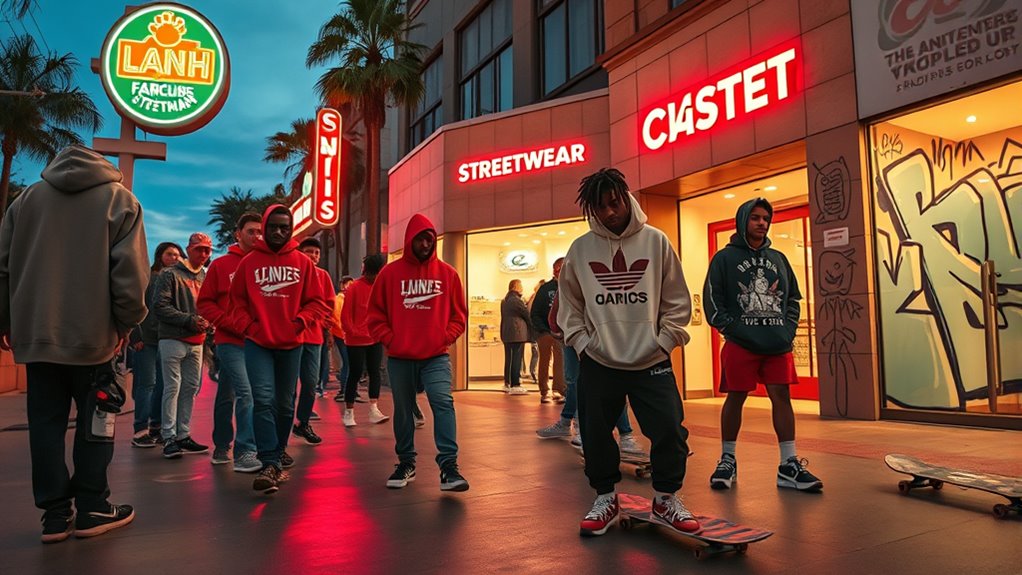
You’ll notice how skater brands gained popularity by emphasizing comfort and individuality, shaping streetwear’s early identity. Hip-hop culture played a huge role, influencing styles and attitudes that resonated with youth worldwide. Collaborations with designers then pushed streetwear into mainstream fashion, blending creativity with commercial appeal. Additionally, streetwear’s growth has been supported by comfort and support solutions, which have become integral to the style’s emphasis on casual, functional apparel.
Rise of Skater Brands
As skateboarding culture gained popularity in the late 20th century, a new wave of brands emerged to reflect its rebellious and individualistic spirit. These skater brands prioritized authenticity, often emphasizing streetwear sustainability to appeal to environmentally conscious consumers. Their influence shifted consumer behavior, making casual, functional apparel a streetwear staple. Iconic brands like Vans and Element grew rapidly, resonating with skaters and non-skaters alike. They championed product durability and style, reinforcing the subculture’s core values. The rise of these brands also prompted a focus on community and self-expression through fashion, fueling demand for limited editions and collaborations. This movement transformed skate-inspired streetwear from niche to mainstream, shaping the broader evolution of streetwear from underground to global fashion phenomenon. Additionally, the integration of brand collaborations and innovative marketing strategies further propelled their rise into high fashion.
Influence of Hip-Hop Culture
Hip-hop culture in the late 20th century sparked a streetwear revolution by blending music, fashion, and attitude into a powerful movement. You see this influence in how sneaker culture exploded, with artists and fans alike showcasing bold sneakers as symbols of identity. Streetwear photography captured these moments, highlighting the style’s raw, authentic vibe rooted in hip-hop’s roots. Artists like Run-DMC popularized collaborations with sneaker brands, turning kicks into cultural icons. This era also saw brands like FUBU and Rocawear emerge, directly inspired by hip-hop’s bold expression. You can trace today’s high-fashion streetwear back to these roots, where music, style, and street photography combined to create a lasting cultural influence that still shapes trends. Additionally, the rise of urban fashion as a mainstream phenomenon helped solidify streetwear’s position in contemporary high fashion.
Collaborations With Designers
The rise of collaborations between streetwear brands and high-profile designers transformed the industry by blending luxury fashion with street style. You’ve likely noticed sneaker collaborations that push boundaries, offering exclusive designs that appeal to both sneakerheads and fashion enthusiasts. These partnerships often showcase innovative use of sustainable materials, reflecting a growing demand for eco-friendly fashion. By teaming up with designers, streetwear brands elevate their credibility and reach a broader audience, merging comfort with high design. This synergy has led to limited-edition drops that create hype and exclusivity, fueling the industry’s growth. As a result, streetwear’s influence now extends beyond subculture, shaping trends on high fashion runways and encouraging brands to prioritize sustainability while maintaining their edgy appeal. Additionally, the adoption of SWIFT/BIC codes ensures secure and efficient transactions for collaborations and global expansion.
The Influence of Subcultural Icons and Artists
Subcultural icons and artists have played a pivotal role in shaping streetwear’s evolution, often serving as style pioneers who challenge mainstream fashion norms. Their influence helps define subcultural identities and drives the ongoing style evolution. These figures set trends that resonate beyond their communities, inspiring brands and consumers alike. By pushing boundaries, they transform streetwear from underground expressions into global phenomena. Their unique aesthetics and rebellious attitudes encourage authenticity, making their impact timeless. Recognizing their role helps you understand how individual creativity fuels collective change in fashion.
| Icon/Artist | Subcultural Identity | Key Contribution |
|---|---|---|
| Kanye West | Hip-Hop, Mainstream | Elevated streetwear to high fashion |
| Virgil Abloh | Skate, Youth Culture | Merged streetwear with luxury |
| A$AP Rocky | Music, Fashion | Popularized bold, eclectic styles |
| Travis Scott | Music, Street Style | Collaborations that boost streetwear visibility |
| Takashi Murakami | Art, Pop Culture | Merged art with streetwear aesthetics |
The Role of Graffiti and Visual Art
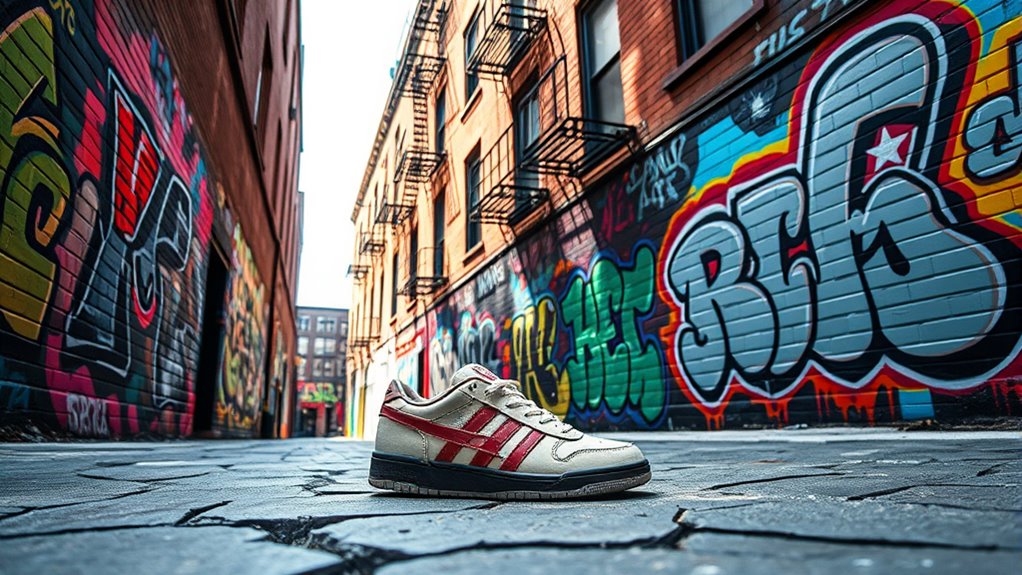
Graffiti and visual art have profoundly shaped streetwear’s aesthetic by bringing bold, expressive imagery into mainstream fashion. You see this influence everywhere—vivid graffiti murals decorate urban landscapes, inspiring clothing designs and graphic prints. Artists like Jean-Michel Basquiat and Keith Haring, whose visual art merged street culture with fine art, helped legitimize graffiti as an art form. These murals and artworks communicate rebellion, identity, and community, which resonate deeply in streetwear’s ethos. Designers incorporate graffiti-inspired tags, spray paint effects, and vibrant colors to create eye-catching pieces. This integration elevates street art from subcultural expression to a core element of streetwear’s visual identity, making it a powerful tool for self-expression and cultural commentary within the fashion scene. Additionally, the rise of hackathons has fostered collaborative innovation, inspiring designers and artists to experiment with new techniques and digital tools that further enhance streetwear design and cultural engagement.
Streetwear’S Intersection With Music and Entertainment
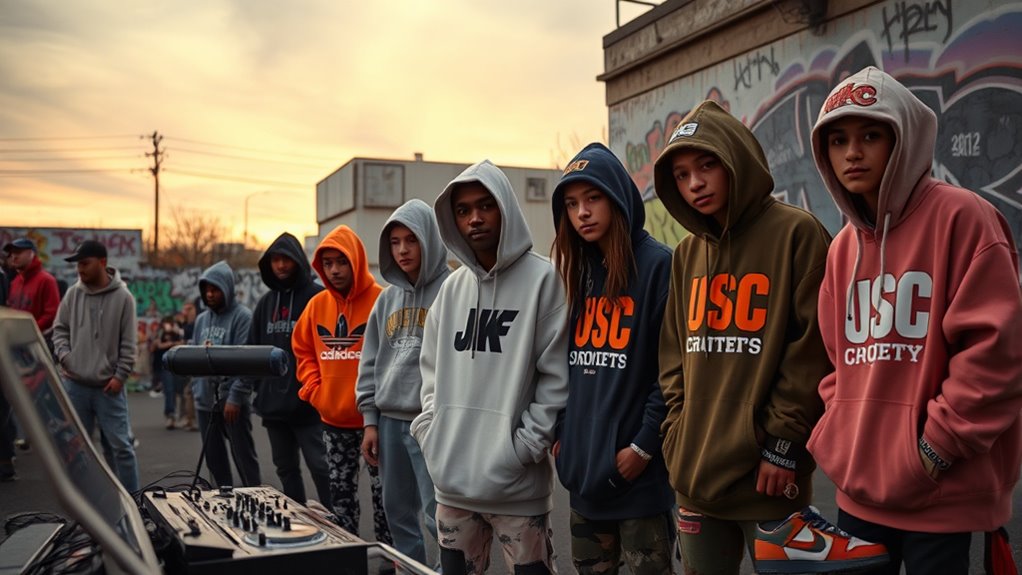
Streetwear’s connection to music and entertainment has amplified its cultural influence, turning fashion into a statement that resonates beyond clothing. You see this in how urban dance scenes often feature streetwear as a key element, shaping styles that emphasize individuality and movement. Musicians and entertainers frequently collaborate with streetwear brands, blending music culture with fashion to create iconic looks. The influence of street art culture also plays a role, inspiring bold graphics and graffiti-inspired designs on apparel. These intersections deepen streetwear’s roots in urban communities, making it more than just clothing—it’s a form of self-expression tied to music, dance, and visual culture. This synergy fuels its popularity, helping streetwear transcend subculture boundaries and enter mainstream entertainment.
The Expansion Into Mainstream Fashion
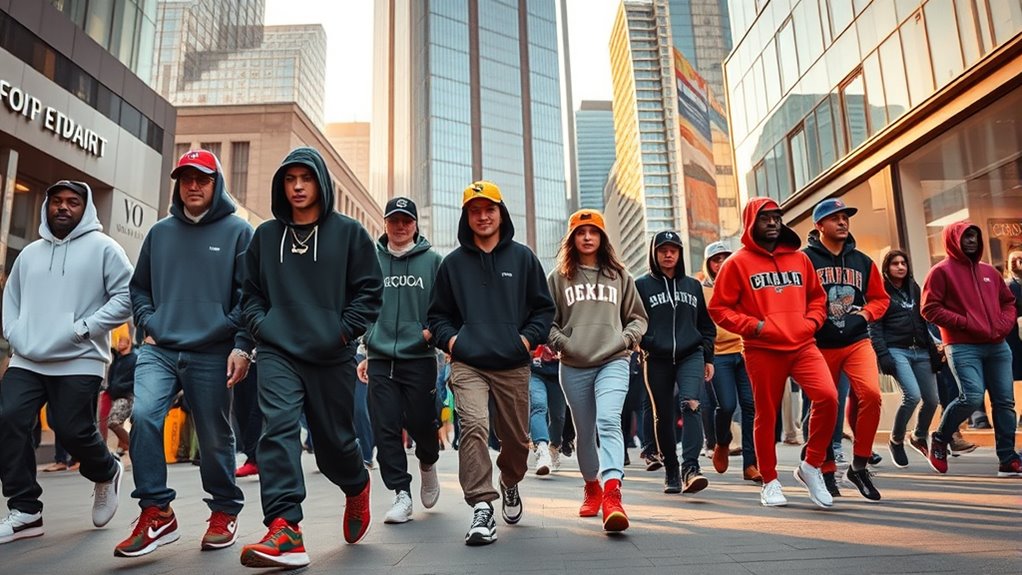
How did streetwear shift from an urban subculture to a mainstream fashion phenomenon? It happened as brands embraced luxury branding, elevating streetwear’s status. High-profile collaborations and influencer endorsements blurred the lines between casual and couture, catching the attention of fashion insiders. Major labels began incorporating streetwear elements into their collections, leading to runway debut appearances that showcased its influence on high fashion. This shift attracted a broader audience, making streetwear not just a subculture but a symbol of status and style. As designers and brands recognized its commercial potential, streetwear’s expansion into mainstream fashion accelerated, transforming it from an underground movement into a key component of global luxury fashion markets. Additionally, the increasing emphasis on vetting safety and quality in products has helped legitimize streetwear brands in the high fashion industry.
Collaborations Between Streetwear and Luxury Labels
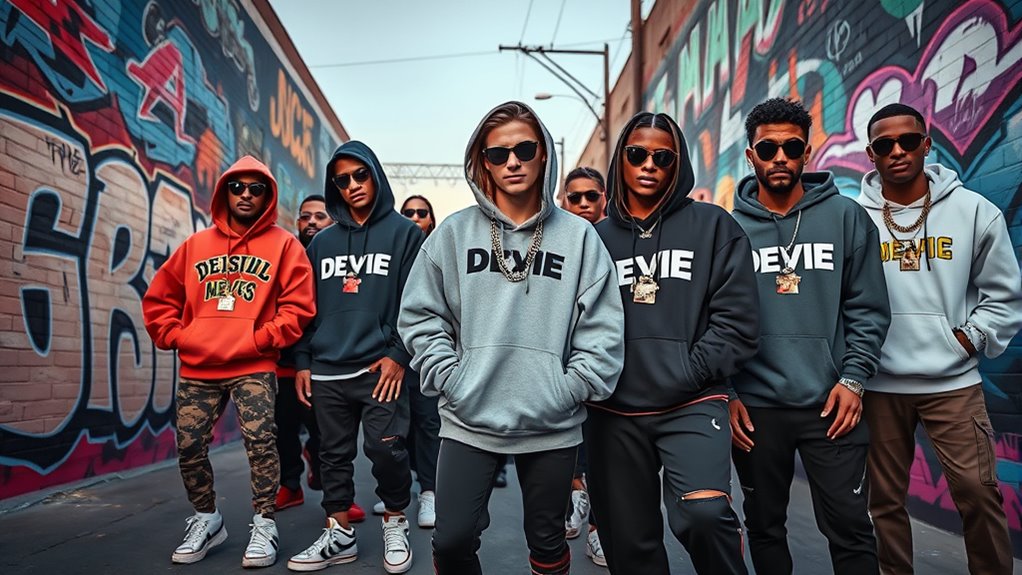
You’ll notice that high-profile collaborations between streetwear brands and luxury labels are becoming more common, blending two distinct worlds. These partnerships often result in limited-edition releases that generate buzz and exclusivity. They’re reshaping fashion by crossing sector boundaries and creating new opportunities for both sides. Additionally, these collaborations reflect the cultural significance of streetwear as a form of self-expression and identity.
High-Profile Partnerships Emerge
As luxury brands recognize the growing influence of streetwear, high-profile collaborations have become a powerful strategy to capture new audiences and redefine their image. These partnerships often blend streetwear’s authenticity with luxury’s craftsmanship, expanding their reach globally. They also spotlight sustainable manufacturing practices, appealing to conscious consumers. Here are four key impacts:
- Brand Revitalization – Reinforces relevance among younger generations.
- Market Penetration – Facilitates global retail expansion into new demographics.
- Sustainable Innovation – Promotes eco-friendly materials and processes.
- Cultural Fusion – Merges streetwear’s subcultural edge with luxury sophistication.
These collaborations shape a new landscape where high fashion and streetwear coexist, creating fresh opportunities for both sectors.
Bridging Fashion Sectors
Bridging the gap between streetwear and luxury fashion has become a defining trend in recent years, driven by brands seeking to innovate and reach new audiences. Collaborations now focus on sustainability and gender-neutral fashion, making luxury more inclusive and eco-conscious. These partnerships evoke emotion by blending high-end craftsmanship with streetwear’s raw energy, breaking traditional boundaries.
| Streetwear Focus | Luxury Focus | Shared Vision |
|---|---|---|
| Sustainable materials | Iconic designs | Inclusive innovation |
| Gender-neutral fashion | Premium quality | Breaking stereotypes |
| Urban culture | Timeless appeal | Connecting communities |
This fusion inspires you to see fashion as a platform for change, emphasizing sustainability and diversity while pushing creative limits.
Limited-Edition Releases
Have you noticed how limited-edition releases have transformed the streetwear and luxury landscape? These collectible drops create buzz and exclusivity, blending streetwear’s rebellious spirit with high fashion’s sophistication. Limited releases often sell out instantly, fueling hype and demand. Here are four key impacts:
- They elevate streetwear’s status, making it desirable for collectors.
- They foster collaborations that push creative boundaries.
- They generate hype, increasing brand prestige and value.
- They turn everyday items into sought-after collectibles.
These limited releases blur the line between affordable streetwear and luxury, making the collaboration a strategic move for brands to attract new audiences and boost desirability. As a result, these collectible drops become more than fashion—they turn into cultural phenomena.
The Impact of Social Media and Digital Platforms
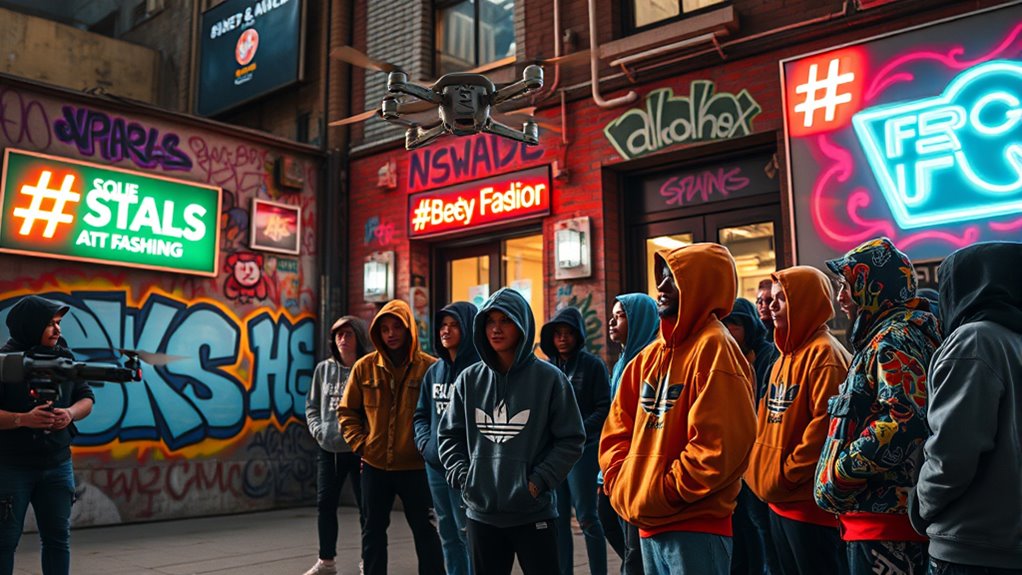
Social media and digital platforms have revolutionized how streetwear brands connect with their audiences and spread trends. With digital influence, social media becomes a powerful tool for sharing new releases, behind-the-scenes content, and collaborations instantly. Platforms like Instagram, TikTok, and Twitter allow brands and influencers to reach millions of followers, creating a rapid feedback loop that accelerates trend adoption. You can see how a single post or viral challenge can propel a niche brand into mainstream recognition overnight. This immediacy shifts power from traditional fashion gatekeepers to consumers, who now shape what’s popular. As a result, streetwear’s evolution is heavily driven by social media, making it more accessible, dynamic, and responsive than ever before.
Streetwear’s Evolution in the Modern Fashion Industry
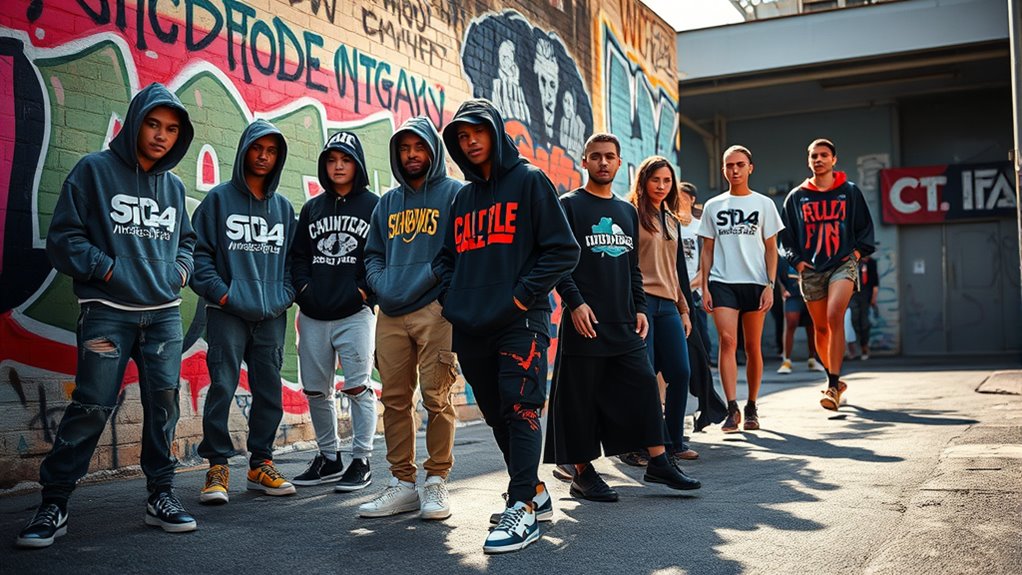
The rapid spread of streetwear trends through social media has transformed how the industry evolves, making it more responsive and interconnected than ever before. Today, brands prioritize sustainable materials and ethical manufacturing to meet consumer demand for authenticity and responsibility. As a result, you’ll notice these key shifts:
- Increased focus on eco-friendly fabrics to reduce environmental impact
- Transparency in supply chains, emphasizing ethical labor practices
- Collaborations with sustainable brands to innovate and push boundaries
- Consumer awareness driving brands to adopt responsible production methods
These changes reflect streetwear’s evolution from a rebellious subculture to a mainstream force, shaping the future of fashion with sustainability at its core. You’re now part of a movement that values both style and social responsibility.
Frequently Asked Questions
How Did Streetwear Influence Mainstream Luxury Fashion Beyond Collaborations?
Streetwear’s influence on mainstream luxury fashion goes beyond collaborations by shaping designs through sneaker culture and music influence. You see luxury brands adopting streetwear aesthetics, like oversized fits and bold graphics, inspired by urban style. Music icons and sneaker culture drive trends, making streetwear elements desirable and mainstream. This blend pushes luxury brands to innovate and appeal to younger audiences, creating a dynamic fusion of high fashion and street style.
What Role Did Geographic Locations Play in the Development of Streetwear Styles?
Imagine strolling through vibrant urban hubs where graffiti murals clash with sleek storefronts. You see how regional influences shape streetwear styles—New York’s gritty edge, Tokyo’s futuristic flair, LA’s laid-back vibe. These geographic locations act as creative melting pots, fueling diverse trends. You realize that each city’s unique culture and environment ignite distinct fashion expressions, making streetwear a dynamic tapestry woven from regional influences across the globe.
How Have Streetwear Brands Maintained Authenticity Amidst Rapid Commercialization?
You can uphold authenticity by fostering brand loyalty through genuine connections with your community. Limited editions help you stay true to your roots, creating exclusivity that resonates with fans. By consistently delivering unique, high-quality products and engaging authentically on social media, you keep your brand’s spirit alive. This approach ensures your audience feels valued and connected, even as your streetwear brand grows and evolves in a rapidly commercialized market.
What Are the Key Cultural Shifts That Propelled Streetwear Into High Fashion?
You see, cultural shifts like urban identity and youth rebellion propelled streetwear into high fashion. As cities showcased their unique styles, designers recognized the raw, rebellious spirit. Youths challenged conventions, creating a vibrant visual vocabulary that caught the attention of luxury labels. This transformation turned streetwear from simple subculture statements into sophisticated style symbols, seamlessly blending street smarts with runway relevance.
How Do Streetwear and Digital Culture Continue to Shape Each Other?
You see how streetwear and digital culture influence each other through viral memes and social media. When you share or engage with trendy posts, you help amplify streetwear brands and trends, making them more mainstream. Social media platforms act as real-time showcases, enabling designers and fans to connect, collaborate, and innovate rapidly. This ongoing interaction keeps streetwear fresh, relevant, and deeply embedded in digital culture, shaping future styles effortlessly.
Conclusion
Now, you’re witnessing a fashion revolution that’s taken over the world—turning skate parks into runways and graffiti into high art. Streetwear’s journey from underground subculture to the pinnacle of high fashion is nothing short of extraordinary. This isn’t just clothing; it’s a movement that’s reshaping how you see style, identity, and self-expression. Get ready, because streetwear’s influence is only going to grow, and you’re right there in the epicenter of it all.
